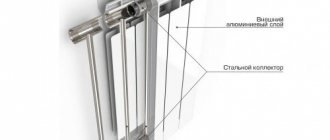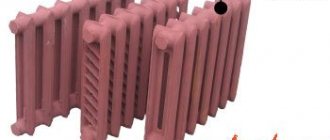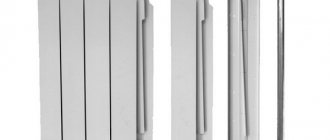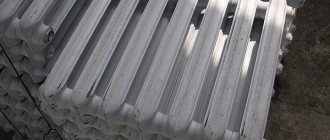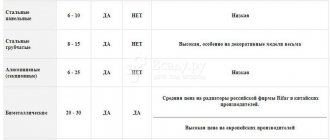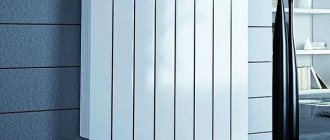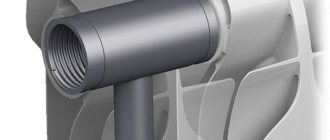The efficiency of the batteries determines the speed and quality of heating. The modern equipment market offers all kinds of solutions. One of the worthy options are bimetallic heating radiators that meet the main requirements of the heating network: strength, resistance to water hammer, high heat transfer and durability.
We will tell you how to choose the right heating device, in the manufacture of which two metals were used. Our article describes in detail the varieties popular among consumers. Their technical characteristics are given and leading manufacturers are listed.
Structure of bimetallic radiators
Externally, bimetallic models resemble conventional aluminum radiators. The difference lies in the internal content. The design of composite products consists of two basic elements: an internal steel pipe and an external figure-ribbed body made of aluminum panels. Some radiators use copper instead of steel.
The coolant circulates through an internal steel or copper pipeline. Due to corrosion inertness, radiators do not rust and do not react with chemically active coolant. The external elements and the internal manifold are connected by spot welding or injection molding.
Based on their physical and operational properties, the batteries are suitable for installation in apartment buildings of any number of floors and for arranging a local heating system for cottage buildings.
The bimetallic structure determines the characteristics of the device. The steel core explains resistance to aggressive environments and endurance to pressure drops, the aluminum “shell” increases heat transfer and makes the radiator lighter
Materials used
The core of the bimetallic radiator section is made of steel pipes. For batteries of normal strength (working pressure 16 - 20 atm), the core is made of carbon steel grade St.3 or its foreign analogues (for example, Tenrad radiators). The core (frame) of high-strength models is welded from stainless steel pipes. High-strength devices with a stainless steel core (for example, Biliner from Royal Thermo) can withstand burst pressures of more than 100 atm.
The outer part of bimetallic radiators is made of aluminum by injection molding. The extrusion method used in the production of some aluminum models cannot be used in this case, since a core must be placed inside the workpiece before forming begins. O-rings are made from heat-resistant silicone rubber.
Profiled fins.
Features of different heating convectors
You should understand the differences between different types of batteries made of two metals. Composite products are usually classified according to the following criteria: composition of the internal rod, external design and type of metal used.
Bimetallic and semi-bimetallic radiators
Users often confuse true bimetallic batteries with “half-breeds” - semi-bimetallic counterparts.
"Pure" bimetal
Aluminum is used to make the outer casing of the device. The convector core is 100% stainless steel or copper. During the production process, pipes placed in special molds are filled under pressure with aluminum - a sealed structure is formed.
The outer shell is not in contact with the coolant and acts as a heat exchanger. The main feature of bimetallic radiators is their high strength and guarantee against leaks
A high-grade bimetal withstands the pressure of centralized and autonomous heating systems.
Semi-bimetallic batteries
The internal “skeleton” of the radiator is made of two metals: vertical guides – stainless steel, horizontal pipeline – aluminum. The reverse combination is also possible.
Such an alliance of metals is not able to ensure adequate reliability of central heating communications. The coolant may contain alkali, which, when interacting with aluminum, provokes corrosion. Over time, destructive processes “transition” to the steel components of the radiator.
In addition, the integrity of the product may be at risk due to thermal expansion of metals - leaks are possible at boundary temperatures.
Externally, semi-bimetallic radiators do not differ from their full-fledged bimetallic counterparts. "Half-breed" gives lighter weight and lower cost
It is better to avoid purchasing low-quality composites, especially when it comes to centralized heating.
Sectional and monolithic models
Among the variety of bimetallic heating batteries, there are two types of designs:
- sectional:
- monolithic.
Models assembled from sections are attractive due to their variability of characteristics. They provide the opportunity to purchase a device with the exact heat transfer values required for heating rooms. Monolithic ones do not have such advantages.
Typesetting systems
Collapsible radiators, the panels of which are connected using nipples. Horizontal sections of pipes of individual sections have multi-directional threads for joining the fastening nipples and the sealing strip.
Stacked models are more popular due to their practicality - it is possible to regulate the thermal power by adding or subtracting the required number of sections. An additional advantage is maintainability.
Disadvantages of sectional radiators:
- joints are weak points of collectors where leaks are likely;
- limited operating pressure – up to 20-30 bar.
Significant disadvantages also include partial ingress of coolant onto the aluminum “jacket” during leakage.
Monolithic devices
One-piece modifications do not have the listed disadvantages. The cast radiator is capable of withstanding pressure surges within 100 atmospheres.
Disadvantages of monolithic batteries: there is no possibility to vary the thermal power, inflated cost - 20-30% more expensive than sectional models with similar parameters
For high-rise buildings (10 or more floors), experts recommend choosing solid radiators, since there will be significant pressure in the heating system.
Copper or steel core?
Most manufacturers offer hybrid batteries with a steel tube frame. The main reason is the affordability of the metal and good strength characteristics. The symbiosis of steel and aluminum made it possible to achieve resistance to pressure fluctuations in the heating system, increase the level of heat transfer of the convector and reduce its inertness.
In copper + aluminum radiators, the heat exchange tubes are made of copper. Heating panels - aluminum plates soldered to an internal copper frame
Advantages of copper core batteries:
- there is no likelihood of corrosion;
- a copper pipeline withstands any water hammer - the best option for use in domestic centralized heating systems;
- high efficiency of the device - the heat transfer of copper exceeds that of steel.
Copper-aluminum radiators have a service life of more than 50 years. The disadvantage of copper modifications is the high price.
Method of connecting sections
In bimetallic heating radiators, the sections are connected to each other using steel threaded nipples. In the manufacture of Monolit series radiators from the Rifar company, another type of connection is used - welding. This model of heating devices can withstand increased pressure (operating up to 100 atm) and temperature (up to 135°C versus 110°C for nipple models).
Diagram of a monolithic radiator.
Bimetallic radiators are the most technically advanced heating device for water heating systems. Combining high efficiency and good performance indicators, devices of this type are optimal for use in domestic conditions. Knowing the technical characteristics of bimetallic heating radiators of various models, you can choose a heating device that best suits the operating conditions in a particular room.
Technical and operational characteristics
All basic parameters of the radiator are indicated in the passport of the heating device.
In order not to make a mistake with your choice, you need to understand the meaning of the following characteristics:
- heat transfer;
- operating pressure and temperature;
- center distance;
- dimensions;
- capacity, section weight.
Thermal power. The parameter indicates the amount of heat transferred from the battery to the atmosphere of the room at a given coolant temperature (+70°C). The indicator is measured in W.
The average heat transfer value of a composite radiator is 140-190 W. The difference in values is explained by the dimensions of the section and the design features of devices from different manufacturers.
Based on the thermal power of one section, the required battery performance for the entire room is calculated.
Work environment indicators. The maximum coolant pressure depends on the thickness of the steel core. The choice of strength is at the discretion of the manufacturer. The parameter value ranges from 15 to 35 bar and is determined based on the operating conditions of the battery.
An important characteristic is the limiting temperature of the coolant. All high-grade bimetals can withstand +90°C. Some manufacturers claim higher thermal resistance.
The maximum temperature stated in the equipment data sheet for different trade positions: Global Style – 110°C, Tenrad – 120°C, Altermo – 130°C, Grandini – 120°C
Radiator dimensions. Dimensional characteristics include the following parameters:
- Center distance is the “distance” between the axes of horizontal collectors. The standard size is 20-80 cm. Vertically oriented models with increased interaxial distance are used if the room layout is not suitable for installing horizontal radiators.
- Geometric parameters determine the height, width, and depth of the section. The total height of the radiator often exceeds the interaxial range by 6-8 cm. The traditional width of the fins of bimetallic models is 80 mm.
The depth of the section is 75-100 mm. Some manufacturers, in addition to external panels, add parallel fins to the design to increase heating efficiency due to convection flows.
Overall dimensions: a – section height, b – distance between horizontal axes, c – battery depth, d – width of one section. The most popular products with a core height of 35 cm, 50 cm
Volume and mass. In bimetallic modifications, the coolant circulates through a core of round cross-section, in contrast to aluminum counterparts with a heat conductor of oval cross-section. The capacity of one bimetal section is less than the volume of an aluminum section with the same standard dimensions.
For example, in convectors with an interaxial range of 500 mm, the coolant filling is about 0.2-0.38 l, with a core height of 350 mm - 0.15-0.25 l.
The weight of a standard bimetallic battery with dimensions of 580/80/80 mm (height/width/depth, respectively) and an axial distance of 50 cm is 1.8-2 kg. Less mass is one of the signs of a semi-bimetal.
Thermal power of radiators with different center distances
The second key characteristic of bimetallic radiators is thermal power . Using this parameter, it is determined how many radiator sections are needed to effectively heat a room of a certain area. This characteristic of a bimetallic radiator directly depends on the value of the center distance :
- 500 mm - thermal power ranges from 170 to 200 W.
- 350 mm - from 120 to 140 W.
- 300 - from 100 to 145 W.
- 200 - about 100 W.
The exact value of the thermal power depends on the modification of the device; this characteristic of the bimetallic radiator is indicated in the technical data sheet for the product. It is calculated as follows: the amount of heat given off by the radiator is estimated at a working environment temperature of +70 degrees Celsius. Let us remind you that in Russia the following standard is used: to heat a room with an area of 10 square meters, a thermal power of 1 kW is required .
To determine the required number of sections, you can use the following formula: N=S*100/Q , where:
- N is the optimal number of sections.
- S is the area of the room.
- Q is the section’s passport indicator.
Comparative analysis: bimetal and competitors
Before choosing a bimetallic or other radiator, it is advisable to compare its capabilities with its closest competitors. For composite convectors these are aluminum, cast iron, steel batteries.
The assessment should be carried out according to the main criteria:
- heat transfer;
- endurance to pressure changes;
- wear resistance;
- ease of installation;
- appearance;
- durability;
- price.
Heat release. In terms of heating efficiency, aluminum units are the leaders, bimetal takes an honorable second place. Steel and cast iron radiators are noticeably inferior.
Aluminum is characterized by minimal thermal inertia - after starting the system, the air in the room warms up within 10 minutes
Resistance to water hammer. The most durable are bimetallic units, capable of withstanding up to 40 atmospheres (sectional models). The maximum operating pressure on an aluminum heating system is 6 bar, a steel one is 10-12 bar, and a cast iron one is 6-9 bar.
It is the bimetal that can withstand numerous water hammer shocks from a centralized heating system. This property is a key argument in favor of composite radiators for apartment buildings.
Chemical inertness. According to this criterion, positions were distributed as follows:
- Cast iron. The material is indifferent to adverse environments. Cast iron radiators can be used for decades, transporting an “alkaline”, “acidic” environment.
- Steel and bimetal. The steel core itself withstands the effects of aggressive components. The weak point of a steel pipeline is its interaction with oxygen, contact with which leads to the formation of rust.
- Aluminum. The metal reacts with various impurities in water.
Aluminum walls are especially susceptible to acidic environments - the pH of the coolant must be within 8. Otherwise, corrosion will actively develop.
Easy to install. In terms of installation, aluminum and bimetallic products are easier. Cast iron radiators are more difficult to install due to their impressive weight.
In terms of durability, the leaders are composite and cast iron batteries. Aluminum and steel products, subject to operational requirements, must be replaced after 10-15 years. Among the designated batteries, bimetallic ones are the most expensive
We can conclude. The purchase of a bimetallic radiator is definitely justified for assembling a heating network in a multi-storey building, where there are risks of pressure surges and contamination of the coolant. In a private house, with stable operation of the boiler and filtration of incoming water, affordable aluminum batteries can be used in the heating device.
Recommendations for selection
Let's summarize. To make the right choice, you must pay attention to all of the following characteristics:
- Design. For a city apartment, a monolithic, fully bimetallic battery is suitable, which can withstand pressure up to 15 atmospheres or more (usually in apartments a pressure of around 12 atmospheres is used, while in a private house it is recommended to set the pressure to just one atmosphere). Cheaper models are suitable for autonomous heating systems, since they do not have high pressure.
- Size. If the distance between the floor and the window sill is at least 80 centimeters, you should choose the highest model. Otherwise, you will have to take a smaller radiator, so that it is at least 12 cm to the floor, and at least 10 cm to the window sill.
- Capacity. One of the main properties is rather narrow passages. If possible, ensure good quality water supplied to the heating system.
- Calculation of sections. Before purchasing, read the model description to clarify the energy capacity. It is better to calculate the number of sections using the second (detailed) formula, where the required amount of heat is determined based on the volume of the room. Do not forget to add 10% in case of significant heat loss due to external factors.
Today, bimetallic batteries from Italian manufacturers Fondital and Global have proven themselves well.
Video on the topic:
What should you consider when choosing a radiator?
To achieve the proper thermal effect, it is necessary to calculate the total power of the battery. Bimetallic equipment is not a cheap purchase, so you should take care of its durability. The conscientious execution of the radiator is guaranteed by trusted manufacturers.
Capability assessment - thermal calculation
Having decided on the appropriate technical characteristics and dimensions of bimetallic radiators, it is necessary to calculate the required number of sections.
Basic formula: N=Ptot./Ppass., where Ptot. – required battery power for the entire room, Ppass. – thermal power of the section according to accompanying documents
The section’s heat transfer rate is taken from the radiator’s passport, and the total power must be calculated.
Calculation by area
The normalized value of thermal power per 1 sq.m of living space for the average climate zone, subject to standard ceilings (250-270 cm):
- the presence of one window and a wall with access to the street - 100 W;
- there is a window in the room, two walls adjacent to the street - 120 W;
- several windows and “external” walls – 130 W.
Example. The section power is 170 W, the total area of the heated room is 15 sq.m. Additional conditions: window – 1, external wall – 1, ceiling height – 270 cm.
N=(15*100)/170 = 8.82.
Rounding is done upward. This means that to heat the room it is necessary to use 9 sections of 170 W each.
Calculation by volume
SNiP separately regulates the amount of thermal power per 1 cubic meter of space in the amount of 41 W. Knowing the volume of the heated room, it is easy to calculate the heat transfer of the entire battery.
Example. Heating the room with the previous parameters. For the purity of the experiment, we leave the power of the section unchanged - 170 W.
N=(15*2.7*41)/170= 9.76.
It is necessary to install a radiator into 10 sections. The second calculation is considered more accurate. When calculating, attention should be paid to sources of heat loss indoors.
The calculated value must be increased by 10% if the apartment is located on the first/last floor, the room has large windows or the wall thickness does not exceed 250 mm
How to avoid fakes: radiator inspection
In addition to analyzing passport data, it would be useful to conduct a visual assessment of the product. Some manufacturers, in pursuit of customers, tend to “embellish” their products by introducing incorrect data into the documentation.
First of all, pay attention to the thickness of the core and aluminum “jacket”, overall dimensions, weight and quality of components.
Steel core. The minimum thickness of the steel tube is 3 mm. With smaller standard sizes, the declared strength of the product - resistance to water hammer and the development of corrosion processes - is significantly reduced.
The walls of thin metal provide access for the coolant to the aluminum “shell”, which, due to chemical activity, begins to quickly collapse
The result of a low-quality steel core is the formation of through holes and the creation of emergency situations in the heating network.
Radiator fins. Aluminum panels must be checked for strength - they should not bend from the efforts of the fingers of one hand. The minimum thickness of the panels is 1 mm.
It is better to choose models with profiled channels between the ribs. The formed confuser increases the speed of air flow, increasing the intensity of convective heat transfer.
To reduce the risk of injury, the outer edges of aluminum panels are rounded. There should be no streaks, uneven coloring or “gaps” on the surface.
Dimensions and weight. By individual order it is possible to produce radiators with a section width of less than 80 mm. However, store-bought models with inappropriate parameters are most likely fake.
To reduce costs, some manufacturers significantly reduce the width of the internal ribs, “masking” them behind standard-sized front panels. This measure worsens the heat transfer of a bimetallic radiator.
Battery components. It is almost impossible to check the quality of gaskets and nipples on site. Rely on the manufacturer's name and warranty period. Reliable companies guarantee up to 15-20 years of trouble-free operation.
Installation of heating radiators made of bimetal
Bimetal batteries must be installed in accordance with the instructions specified in the device passport.
In order to connect a radiator with your own hands, you need to take into account a number of factors:
- It is better to choose the middle of the window as a location for the battery;
- installation is carried out exclusively in a horizontal position;
- You need to maintain a distance of 3-5 cm from the wall to the battery. If you place the radiator too close to the wall, the result will be uneven distribution of heat;
- the distance to the window sill should be 8-12 cm, if it is less, it will negatively affect the heat transfer of the batteries;
- distance from the floor to the battery is 10 cm.
Installation of all system elements is carried out in a plastic radiator package. This packaging must not be removed until the entire installation process has been completed. The procedure for installing bimetallic heating radiators:
- Initially, you need to mark the proposed area on the wall where the brackets will be attached;
- then the brackets are fixed;
- batteries are installed on them;
- Next, the radiator must be connected to the pipes;
- then a thermostatic valve or faucet is installed;
- An air valve is installed at the top of the battery.
Everything about brackets for mounting radiators is written at the link
Rating of popular manufacturers
The review includes high-quality foreign heating systems and domestic products adapted to the changing conditions of heating networks.
In practice, the company’s products have proven themselves well:
- Global Style (Italy);
- Sira (Italy);
- Rifar (Russia);
- Tenrad (Germany).
Place #1 - Global
This is a generally recognized leader in the production of heating radiators.
The company produces three series of bimetallic batteries:
- Style – basic characteristics;
- Style Extra – compact dimensions;
- Style Plus – maximum heat transfer.
The sections are connected by paronite gaskets, ensuring the tightness of the joints. Efficient heat transfer between metals is achieved through injection molding of an aluminum “jacket”.
Additional characteristics: pressure – up to 35 atm, connection diameter – ¾ or ½ inch, coolant temperature – up to 110°C, outer shell – double painted
Place #2 - Sira
The Italian manufacturer positions its products as premium products. The devices have gained popularity among consumers due to their durability and attractive design. The manufacturer provides a 20-year guarantee for a series of full-fledged bimetallic radiators Sira Ali Metal.
Characteristics of Ali Metal products: center distance – 350/500 mm, heat transfer of models – 187/141 W (according to the center distance), pressure in the heating network – 35 atmospheres
Place #3 – Rifar
A domestic manufacturer has developed a wide range of bimetallic radiators:
- Base – models with center distances of 200/350/500 mm, warranty from Rifar – 10 years;
- Forza – reinforced external coating, resistant to scratches and mechanical damage;
- Alp – shallow depth (75 mm);
- Monolit is a one-piece radiator.
Monolit series batteries are characterized by the highest performance indicator at high coolant pressure.
Technical data: operating pressure – 10 MPa, destruction pressure – 25 MPa, maximum temperature – 135°C, warranty period – 25 years
Location #4 - Tenrad
Bimetal of German quality is suitable for centralized and independent heating networks. Suitable for use in gravity, elevator and pump systems with one- and two-pipe wiring.
Distinctive features:
- the thickness of the vertical tubes is 1.8 mm, the thickness of the collector walls is 3.6 mm;
- three-row fins;
- the side panels are located at a slope, which creates a diffuser effect for convective flow.
Two-layer enamel coating made of high-quality paints and varnishes - when heated, the device does not emit harmful fumes.
Tenrad products are designed for operation in a system with a coolant pressure of up to 35 atmospheres. Bimetallic radiators are certified and comply with the European standard EN442
The following article will introduce you to the rules for calculating the power and number of radiators for a heating device, which you should read before purchasing devices.
What is bimetal
Bimetal is a relatively new type of heating battery material that consists of two metals, a steel core inside and an aluminum casing on top. This combination is designed primarily to work with high pressure in radiators, up to 40 atmospheres.
Without understanding what bimetallic heating radiators are and how they function, it is impossible to think through the heating system of a home. Even if you prefer more economical options, do not rush to abandon bimetal products - after all, they have very high performance characteristics.
When developing such batteries, the designers set out to produce a product that would have the high heat transfer properties of aluminum, but would not have the disadvantage of poor corrosion resistance. The result is a heatsink that incorporates a less demanding steel core within an aluminum shell.
This product perfectly heats the room - the section power is up to 190 W, but lasts an order of magnitude longer than its aluminum “brother”.
Bimetallic heating devices today are the best choice for a city apartment. Elegant and powerful, like aluminum, they perfectly withstand high pressure, water hammer and resist corrosion. Such devices have been successfully used for a long time in open urban heating systems in many Russian cities.
The collectors and vertical channels of such radiators are made of steel tubes, and the outside is filled with aluminum alloy under pressure. Steel holds pressure well, and aluminum transfers heat well to the air.
- It has many other advantages:
- tolerate water hammer well during seasonal startup work;
- ease and simplicity of installation;
- their laconic and elegant appearance makes them suitable for any interior;
- can withstand pressure up to 35 atmospheres;
- can last up to 20 years.
As mentioned, the main disadvantage of such products is their high price. In addition, although steel is more resistant to corrosion than aluminum, it still suffers from it. Especially if air bubbles get into the system. If the coolant is of very low quality and contains small particles, the bimetal will also not be a panacea for rapid wear.
Conclusions and useful video on the topic
The video review clearly demonstrates the design features of composite radiators and the basic requirements that a high-quality device must meet:
Full bimetallic radiators combine the positive characteristics of both materials. The batteries are distinguished by high thermal power, resistance to water hammer and excellent decorative properties. Their purchase is a justified investment provided that you purchase a certified product.
Tell us about how you chose a bimetallic heating device for your own apartment or country house. Share what argument was decisive in your choice? Please leave comments in the block below, ask questions, post thematic photographs.
Which ones are better
Manifolds made of steel completely eliminate contact of the coolant with aluminum. This is the moment that interferes with the normal operation of aluminum batteries in our high-rise buildings. The second point is pressure drops that can occur during system startup and in emergency situations. In general, in normal conditions this indicator in any network is within 6-9 atm. But they try to install heating devices with multiple reserves: water hammer can be very strong. According to these parameters, batteries made from full bimetal are better:
- their operating pressure is approximately 5 atm higher than that of partial (on average 30-40 atm depending on the manufacturer),
- 100% exclusion of contact with coolant.
What is the disadvantage of such radiators? They are expensive. The manufacturing technology is complex: first you need to weld the structure, ensuring the tightness and reliability of the connection, then fuse aluminum onto the frame, giving it a certain shape. It is also necessary to ensure a reliable connection between two different metals, which is not easy. All this affects the price.
Not a single manufacturer wrote: this model only has a vertical steel tube. You have to look into the manifold to understand what it is made of
Another negative point: the lower thermal power of the section. The difference is approximately 10% compared to partial bimetal, and 15-20% with a similar aluminum section.
Partial bimetal has lower strength characteristics. Its horizontal collectors are made of aluminum, that is, they are destroyed by the coolant. But the practice of using aluminum radiators has shown that in most cases it is vertical collectors that are destroyed. So aluminum in horizontal ones does not greatly affect the durability of heating devices. However, the main task and idea - to exclude the contract between aluminum and coolant - have not been completed. In any case, they are more demanding on the quality of the coolant (pH should be in the region of 6-9, and preferably 7-8) and have lower burst pressure (and operating pressure too).
Now about the positives. These batteries are priced between fully bimetallic and aluminum. They have higher heat transfer. Some models can catch up with aluminum. For example, Rifar Base 500 allows you to shoot more than 200 W from one section (at a temperature delta of 70oC).
Read about radiators here.
This is the only fully bimetallic radiator from the Russian
So, which bimetallic radiators are better? I will express my own point of view: if we install bimetal, then complete it. It may be expensive, but it is reliable. And the manufacturer must be chosen wisely. It is quite possible to find high-quality full bimetal, which will be only slightly more expensive in price than partial. But I emphasize once again - this is a personal opinion.
In general, you need to approach it from the point of view of operating conditions. You will need to know the following parameters of your heating network:
- Maximum temperature;
- working and maximum pressure;
- hydrogen index of the coolant (the same pH).
Having this data in hand, you can already decide exactly what is better: a bimetallic radiator with a partially steel manifold, or do you need a frame entirely made of steel.
When asking about network parameters, do not ask for an official answer. You will be given “protocol” values, which, to put it mildly, do not always correspond to reality. It is better to find out this from plumbers who know the real picture, and not the official one.
Blitz tips
- When choosing a bimetallic heating device, you should not completely trust sales consultants who praise this or that model. You should slowly check the heating device yourself for compliance with the parameters set out in this article. If you have doubts about the country in which the heating device was manufactured, you need to read the documentation for the product.
- Installing a bimetallic radiator is a very responsible undertaking that is best left to professionals.
- There is no point in purchasing the most expensive model. The fact that a heating device is more expensive than all other models does not prevent you from purchasing low-quality products for a lot of money.
Advantages of bimetallic batteries
The popularity of radiators of this type is obvious. Cast iron heaters are very reliable, but their appearance is not pleasing to the eye. They are difficult to install. Aluminum batteries look modern and beautiful. However, in the coolant, the metal does not tolerate the combination with oxygen. Therefore, they crack too quickly and begin to leak. Steel heaters last longer, but do not look as attractive. Bimetallic samples combine the advantages of radiators made of steel and aluminum. Such heating products are in perfect harmony with any modern indoor environment. Their sections are made of aluminum, and the pipes through which the coolant flows are made of steel.
